
Elizabeth M. and Toban B. sent in a clip from the British TV show “That Mitchell and Webb Look” that has a humorous take on how advertisers target men and women:
gender: masculinity
I’m not quite sure what to make of this but, after clicking through this Time magazine slide show of Bruno hype by Sacha Baron Cohen, I noticed that there appears to be a rule regarding his entourage: all its members must differ from him in one consistent way and, in that same way, they must all be alike. This translates, in these images, into his entourage always being (a) women or (b) men of color, but never both:
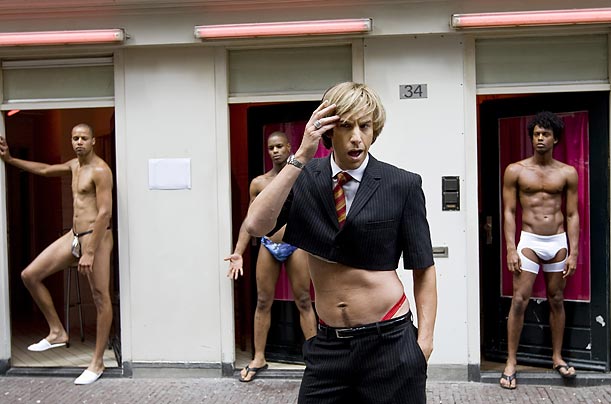
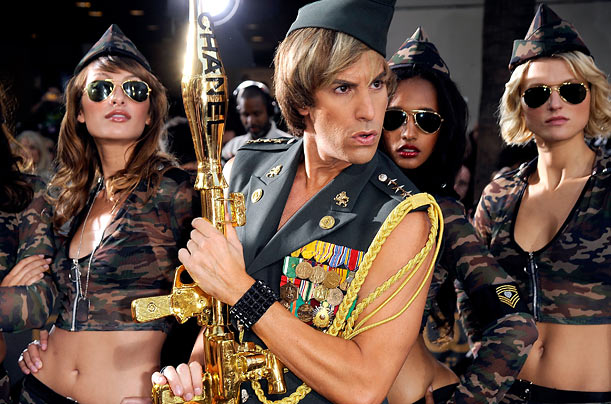
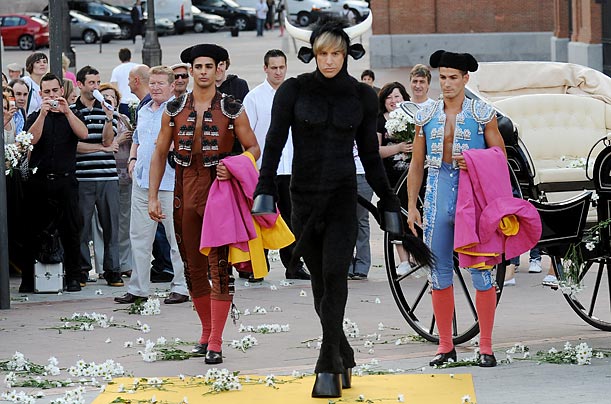
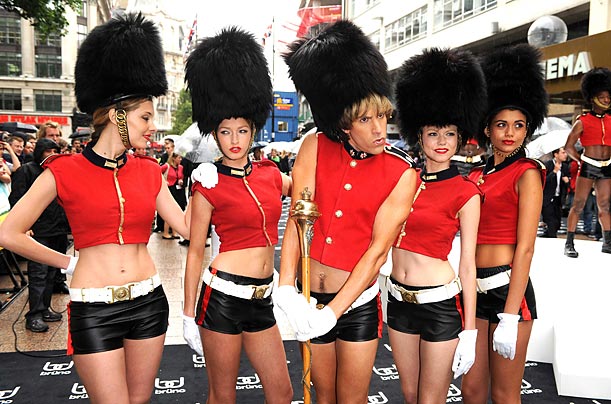
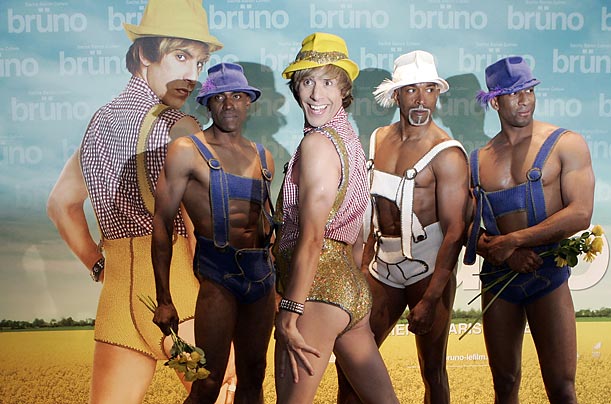
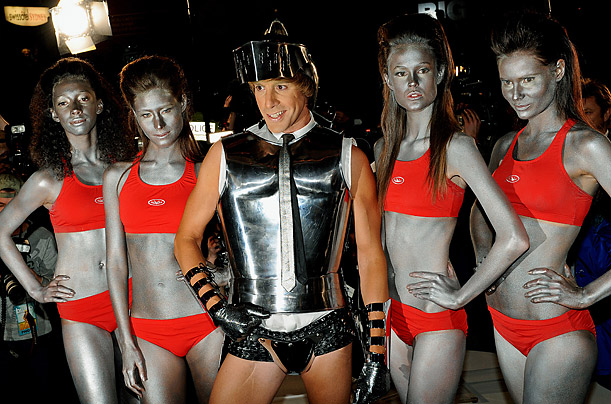
Any thoughts? Is there some social psychologist out there with some speculation? Readers, what do you think?
P.S. – To the person who commented in the thread of our last Bruno-related post about never wanting to see his face again: I say, “Sorry.”
—————————
Lisa Wade is a professor of sociology at Occidental College. You can follow her on Twitter and Facebook.
Various journalists and scholars have pointed out over the years that movies and TV shows often portray as romantic behavior that is fairly indistinguishable from stalking. A good example of this is There’s Something about Mary, in which three men engage in some really sketchy behavior–in one case literally spying on her with binoculars. And while we’re supposed to find them crazy and obsessed, this doesn’t preclude her from getting together with one of them. This type of thing shows up often–one character (usually a guy, though not always) follows another character (who has rejected previous advances) around or sleeps on her lawn or declares he’s in love at first sight or does something else that is supposed to be evidence of deep and abiding love.
But of course, there’s a more disturbing way to interpret that behavior. I once had to contact security and have a man removed from campus when one of my female students anxiously told me that a man she had a restraining order against for stalking (and who wasn’t a student) was outside the classroom. She thought she had escaped him when she moved to college and was very scared that he’d shown up, hours away from their hometown. She didn’t find the behavior romantic or cute; it didn’t make her eventually think she should give him a chance in return for his persistence. It made her feel truly frightened.
Anyway, that’s an overly-long introduction to a video (found here) sent in by Matt W. The creator, Jonathan McIntosh of Rebellious Pixels, edited together scenes from Buffy the Vampire Slayer with scenes of Edward Cullen from the movie Twilight to show how behavior that is depicted as protective and romantic in the film (and book) could also be seen as disturbing:
McIntosh says,
Seen through Buffy’s eyes, some of the more sexist gender roles and patriarchal Hollywood themes embedded in the Twilight saga are exposed in hilarious ways. Ultimately this remix is about more than a decisive showdown between the slayer and the sparkly vampire. It also doubles as a metaphor for the ongoing battle between two opposing visions of gender roles in the 21st century.
I think it’s a great conversation starter (and I’m always happy for an excuse to talk about Buffy).
Gwen Sharp is an associate professor of sociology at Nevada State College. You can follow her on Twitter at @gwensharpnv.
Feminist scholars argue that patriarchy relies not just on a hierarchy that places men above women, but a hierarchy of men that punishes men who don’t obey rules of masculinity.
An advertising campaign for Oberto Beef Jerky, sent in by Kate S., nicely illustrates the threat to men if they don’t comply with patriarchy.

The threat is: If you’re not an “Alpha,” then you’re a “Sidekick.”
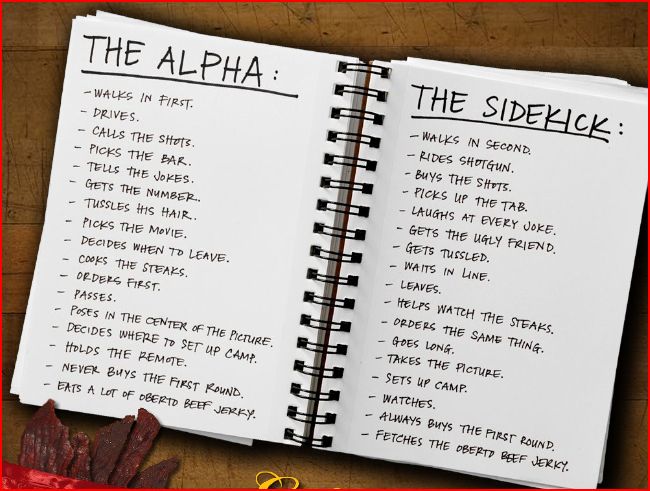
The Alpha is first; the Sidekick is second. The Alpha gets served; the Sidekick serves. The Alpha gets the hot chick; the Sidekick gets the “ugly friend.” The Alpha makes the decisions; the Sidekick takes them.
In one part of the website, it actually encourages you to “establish your dominance.” It features taunting emails and cards that you can send to your friends to trick them into looking like idiots/being your sidekick.
UPDATE: In the comments thread, Toban B. (T B) had a really nice observation:
As Murray Bookchin has written, language about ‘alpha males’ naturalizes hierarchy.
Bookchin highlights how people have conflated animal and insect interactions (e.g. ‘queen’ bees) with societal structures created by humans — as opposed to the far more instinctual of relations of non-human creatures. (For Bookchin, there is a continuum between humans and other life forms, so these distinctions aren’t binaries.) Basically, the point here is that if human hierarchies are the same as instinctual hierarchies (e.g. interactions with a lion ‘king’), then the human hierarchies must be just as natural and inevitable — which just isn’t the case.
Joanne suggests, further, that humans, invested in patriarchy and hierarchy, actually project it onto the natural world:
Using the terms “alpha” and “dominance” just reinforces the belief that nature exists within a patriarchal, hierarchical model. It actually doesn’t. I do a lot of work with horses, researching and observing the horse-human relationship, and this whole idea of “dominance” is one that has started with and is kept alive by the patriarchal worldview of Western culture. Many observers of animal behavior are brought up in and continue to live in that worldview, so they impose it on animals and the natural world. If you step outside of that worldview, what you find in the natural world is something entirely different.
—————————
Lisa Wade is a professor of sociology at Occidental College. You can follow her on Twitter and Facebook.
Lisa Wade, PhD is an Associate Professor at Tulane University. She is the author of American Hookup, a book about college sexual culture; a textbook about gender; and a forthcoming introductory text: Terrible Magnificent Sociology. You can follow her on Twitter and Instagram.
Andrea G. alerted us to a Fisher-Price toy, called My Pretty Learning Purse, for children aged 6 to 36 months. Behold:

The purse comes with a dollar bill, a bracelet, a mirror, and a set of keys. It also sings songs about purple and pink.
Andrea writes:
With these props, a one year old can properly play “woman.” I felt this is an example of how we do gender and teach it to children, as young as a year old.
At least they’re admitting that femininity must be “learn[ed]?”
UPDATE: Jane, in the comments, linked to a Fisher Price product for boys that is very similar:

Get it! It’s a tool box and it includes keys, a screwdriver, a hammer, and a saw.
The play involved in each product is essentially identical (e.g., music, putting things in and taking them out), but the theme of the play is gendered. Do you think this is to please the parents or the kids?
NEW (Dec. ’09)! Monica C. sent along this page from a Target catalog featuring a girl playing with a kitchen and a boy playing with a tool set:

Also in teaching young children femininity and masculinity, see our posts here, here, here, here, here, here, here, here, here, here, here, here, here, here, here, here, here, here, and here.
—————————
Lisa Wade is a professor of sociology at Occidental College. You can follow her on Twitter and Facebook.
Because meat is what men eat…

See also this BEEF! BEEF! BEEF! Campbell’s Soup ad.
From MultiCultClassics.
—————————
Lisa Wade is a professor of sociology at Occidental College. You can follow her on Twitter and Facebook.

Andrea G. sent us a link to this five-minute peek into Sut Jhally and Jackson Katz’s documentary Wrestling with Manhood, about masculinity and professional wrestling.
Jackson Katz has an earlier documentary, Tough Guise, about masculinity and violence. Here are seven-minutes of excerpts:
See also Gwen’s post on changing ideals of masculinity (measured in guns and cars) inspired by Tough Guise.
For more on masculinity and violence, see our posts about how men’s violence is naturalized or made invisible (here and here), our posts on finding humor in men’s violence (here, here, here and here), and some I’m not sure how to characterize (here, here, here, here, and here).
—————————
Lisa Wade is a professor of sociology at Occidental College. You can follow her on Twitter and Facebook.
As an exercise I sometimes ask the students in my gender class to try on the pants of their friends of the opposite sex. That is, I ask women to try on men’s pants and men to try on women’s pants. They often react with surprise at how effectively the jeans make their bodies look like the bodies of their opposite sex friends. (Women often complain that their guy friends look “better” in their jeans than they do!) This starts a discussion of the many ways that our choices about what to wear make it appear as if our bodies are in fact “opposite” when, in fact, they’re not quite as different as we often believe.
We dress ourselves to emphasize certain beliefs about what men’s and women’s bodies should look like by choice, because not doing so carries some negative consequences, and because doing so is institutionalized. It’s institutionalized insofar as department stores have separate men’s and women’s sections (and no unisex section) and jeans are made for and marketed as men’s and women’s.
It doesn’t have to be this way, and wasn’t always. Check out these ads from the 1960s and ’70s:

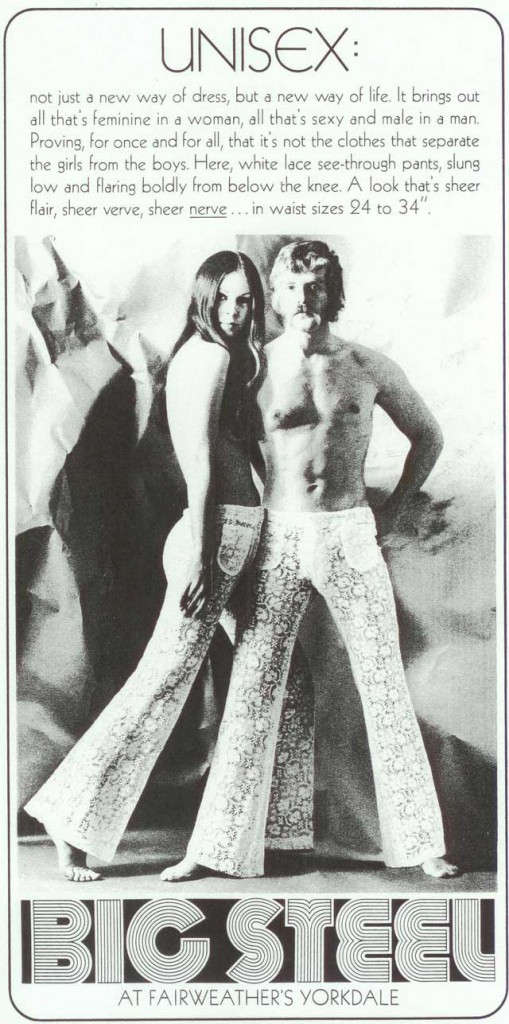
Found at Vintage Ads and the Torontoist.
—————————
Lisa Wade is a professor of sociology at Occidental College. You can follow her on Twitter and Facebook.
I’m not quite sure what to make of this but, after clicking through this Time magazine slide show of Bruno hype by Sacha Baron Cohen, I noticed that there appears to be a rule regarding his entourage: all its members must differ from him in one consistent way and, in that same way, they must all be alike. This translates, in these images, into his entourage always being (a) women or (b) men of color, but never both:






Any thoughts? Is there some social psychologist out there with some speculation? Readers, what do you think?
P.S. – To the person who commented in the thread of our last Bruno-related post about never wanting to see his face again: I say, “Sorry.”
—————————
Lisa Wade is a professor of sociology at Occidental College. You can follow her on Twitter and Facebook.
Various journalists and scholars have pointed out over the years that movies and TV shows often portray as romantic behavior that is fairly indistinguishable from stalking. A good example of this is There’s Something about Mary, in which three men engage in some really sketchy behavior–in one case literally spying on her with binoculars. And while we’re supposed to find them crazy and obsessed, this doesn’t preclude her from getting together with one of them. This type of thing shows up often–one character (usually a guy, though not always) follows another character (who has rejected previous advances) around or sleeps on her lawn or declares he’s in love at first sight or does something else that is supposed to be evidence of deep and abiding love.
But of course, there’s a more disturbing way to interpret that behavior. I once had to contact security and have a man removed from campus when one of my female students anxiously told me that a man she had a restraining order against for stalking (and who wasn’t a student) was outside the classroom. She thought she had escaped him when she moved to college and was very scared that he’d shown up, hours away from their hometown. She didn’t find the behavior romantic or cute; it didn’t make her eventually think she should give him a chance in return for his persistence. It made her feel truly frightened.
Anyway, that’s an overly-long introduction to a video (found here) sent in by Matt W. The creator, Jonathan McIntosh of Rebellious Pixels, edited together scenes from Buffy the Vampire Slayer with scenes of Edward Cullen from the movie Twilight to show how behavior that is depicted as protective and romantic in the film (and book) could also be seen as disturbing:
McIntosh says,
Seen through Buffy’s eyes, some of the more sexist gender roles and patriarchal Hollywood themes embedded in the Twilight saga are exposed in hilarious ways. Ultimately this remix is about more than a decisive showdown between the slayer and the sparkly vampire. It also doubles as a metaphor for the ongoing battle between two opposing visions of gender roles in the 21st century.
I think it’s a great conversation starter (and I’m always happy for an excuse to talk about Buffy).
Gwen Sharp is an associate professor of sociology at Nevada State College. You can follow her on Twitter at @gwensharpnv.
Feminist scholars argue that patriarchy relies not just on a hierarchy that places men above women, but a hierarchy of men that punishes men who don’t obey rules of masculinity.
An advertising campaign for Oberto Beef Jerky, sent in by Kate S., nicely illustrates the threat to men if they don’t comply with patriarchy.

The threat is: If you’re not an “Alpha,” then you’re a “Sidekick.”

The Alpha is first; the Sidekick is second. The Alpha gets served; the Sidekick serves. The Alpha gets the hot chick; the Sidekick gets the “ugly friend.” The Alpha makes the decisions; the Sidekick takes them.
In one part of the website, it actually encourages you to “establish your dominance.” It features taunting emails and cards that you can send to your friends to trick them into looking like idiots/being your sidekick.
UPDATE: In the comments thread, Toban B. (T B) had a really nice observation:
As Murray Bookchin has written, language about ‘alpha males’ naturalizes hierarchy.
Bookchin highlights how people have conflated animal and insect interactions (e.g. ‘queen’ bees) with societal structures created by humans — as opposed to the far more instinctual of relations of non-human creatures. (For Bookchin, there is a continuum between humans and other life forms, so these distinctions aren’t binaries.) Basically, the point here is that if human hierarchies are the same as instinctual hierarchies (e.g. interactions with a lion ‘king’), then the human hierarchies must be just as natural and inevitable — which just isn’t the case.
Joanne suggests, further, that humans, invested in patriarchy and hierarchy, actually project it onto the natural world:
Using the terms “alpha” and “dominance” just reinforces the belief that nature exists within a patriarchal, hierarchical model. It actually doesn’t. I do a lot of work with horses, researching and observing the horse-human relationship, and this whole idea of “dominance” is one that has started with and is kept alive by the patriarchal worldview of Western culture. Many observers of animal behavior are brought up in and continue to live in that worldview, so they impose it on animals and the natural world. If you step outside of that worldview, what you find in the natural world is something entirely different.
—————————
Lisa Wade is a professor of sociology at Occidental College. You can follow her on Twitter and Facebook.
Lisa Wade, PhD is an Associate Professor at Tulane University. She is the author of American Hookup, a book about college sexual culture; a textbook about gender; and a forthcoming introductory text: Terrible Magnificent Sociology. You can follow her on Twitter and Instagram.
Andrea G. alerted us to a Fisher-Price toy, called My Pretty Learning Purse, for children aged 6 to 36 months. Behold:

The purse comes with a dollar bill, a bracelet, a mirror, and a set of keys. It also sings songs about purple and pink.
Andrea writes:
With these props, a one year old can properly play “woman.” I felt this is an example of how we do gender and teach it to children, as young as a year old.
At least they’re admitting that femininity must be “learn[ed]?”
UPDATE: Jane, in the comments, linked to a Fisher Price product for boys that is very similar:

Get it! It’s a tool box and it includes keys, a screwdriver, a hammer, and a saw.
The play involved in each product is essentially identical (e.g., music, putting things in and taking them out), but the theme of the play is gendered. Do you think this is to please the parents or the kids?
NEW (Dec. ’09)! Monica C. sent along this page from a Target catalog featuring a girl playing with a kitchen and a boy playing with a tool set:

Also in teaching young children femininity and masculinity, see our posts here, here, here, here, here, here, here, here, here, here, here, here, here, here, here, here, here, here, and here.
—————————
Lisa Wade is a professor of sociology at Occidental College. You can follow her on Twitter and Facebook.
Because meat is what men eat…

See also this BEEF! BEEF! BEEF! Campbell’s Soup ad.
From MultiCultClassics.
—————————
Lisa Wade is a professor of sociology at Occidental College. You can follow her on Twitter and Facebook.

Andrea G. sent us a link to this five-minute peek into Sut Jhally and Jackson Katz’s documentary Wrestling with Manhood, about masculinity and professional wrestling.
Jackson Katz has an earlier documentary, Tough Guise, about masculinity and violence. Here are seven-minutes of excerpts:
See also Gwen’s post on changing ideals of masculinity (measured in guns and cars) inspired by Tough Guise.
For more on masculinity and violence, see our posts about how men’s violence is naturalized or made invisible (here and here), our posts on finding humor in men’s violence (here, here, here and here), and some I’m not sure how to characterize (here, here, here, here, and here).
—————————
Lisa Wade is a professor of sociology at Occidental College. You can follow her on Twitter and Facebook.
As an exercise I sometimes ask the students in my gender class to try on the pants of their friends of the opposite sex. That is, I ask women to try on men’s pants and men to try on women’s pants. They often react with surprise at how effectively the jeans make their bodies look like the bodies of their opposite sex friends. (Women often complain that their guy friends look “better” in their jeans than they do!) This starts a discussion of the many ways that our choices about what to wear make it appear as if our bodies are in fact “opposite” when, in fact, they’re not quite as different as we often believe.
We dress ourselves to emphasize certain beliefs about what men’s and women’s bodies should look like by choice, because not doing so carries some negative consequences, and because doing so is institutionalized. It’s institutionalized insofar as department stores have separate men’s and women’s sections (and no unisex section) and jeans are made for and marketed as men’s and women’s.
It doesn’t have to be this way, and wasn’t always. Check out these ads from the 1960s and ’70s:


Found at Vintage Ads and the Torontoist.
—————————
Lisa Wade is a professor of sociology at Occidental College. You can follow her on Twitter and Facebook.
